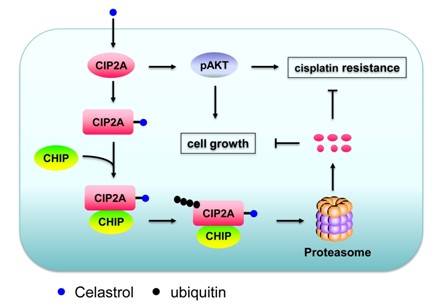Lung cancer is the leading cause of cancer deaths worldwide, killing 1.4 million people annually. Therefore, there is an urgent need to develop new targeted therapies for this deadly disease.
Cancerous inhibitor of protein phosphatase 2A (CIP2A) is a newly discovered endogenous cancerous inhibitor of protein phosphatase PP2A, and functions as an oncoprotein to modulate Akt and stabilize c-Myc, and is required for cell proliferation and malignant transformation. Professor Guangbiao Zhou’s lab found that CIP2A was undetectable or very low in paratumor normal tissues, but was dramatically elevated in lung cancer tumor samples. CIP2A overexpression was associated with cigarette smoking. They found a natural compound, rabdocoetsin B which is extracted from a Traditional Chinese Medicinal herb Rabdosia coetsa, could induce down-regulation of CIP2A and inactivation of Akt pathway, and inhibit proliferation and induce apoptosis in a variety of lung cancer cells (Ma et al. PloS One, 2011). Recently, they reported that a small compound celastrol could induce a rapid degradation of CIP2A, through the ubiquitin-proteasome pathway with the carboxyl terminus of Hsp70-interacting protein (CHIP) as the E3 ligase. Celastrol directly bound CIP2A protein, promoting CIP2A-CHIP interaction and subsequent degradation of CIP2A in non-small-cell lung cancer cells. Celastrol effectively inhibited cell proliferation and induced apoptosis in lung cancer cells, while CIP2A silencing by specific small interfering RNA enhanced these effects. Celastrol also suppressed tumor growth in murine models of lung cancer. In addition, celastrol potentiated the inhibitory effect of chemotherapeutic agent cisplatin on lung cancer cells in vitro and in vivo, via inhibition of CIP2A-Akt pathway.
Their studies indicate that CIP2A is a potential therapeutic target for lung cancer, and since the thunder god vine from which celastrol is extracted has been used for centuries in treating inflammatory diseases, the efficacy of celastrol in lung cancer should be tested in a future work.
This work was published online in journal Carcinogenesis on Dec 1, 2013. The co-first authors were Drs. Zi Liu and Liang Ma, and Professor Guangbiao Zhou was the corresponding author of this paper. This study was supported by grants from The National Key Program for Basic Research and the National Natural Science Foundation of China.
The article can be found at website:
http://carcin.oxfordjournals.org/cgi/content/abstract/bgt395?ijkey=vP0xGuZqzlKhzK9&keytype=ref


